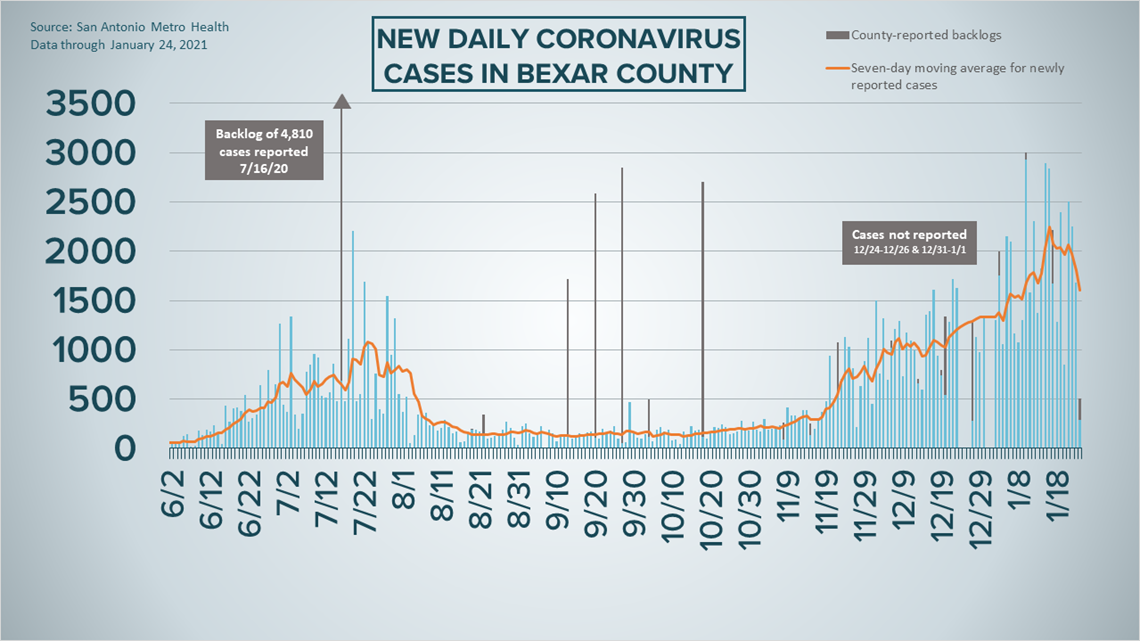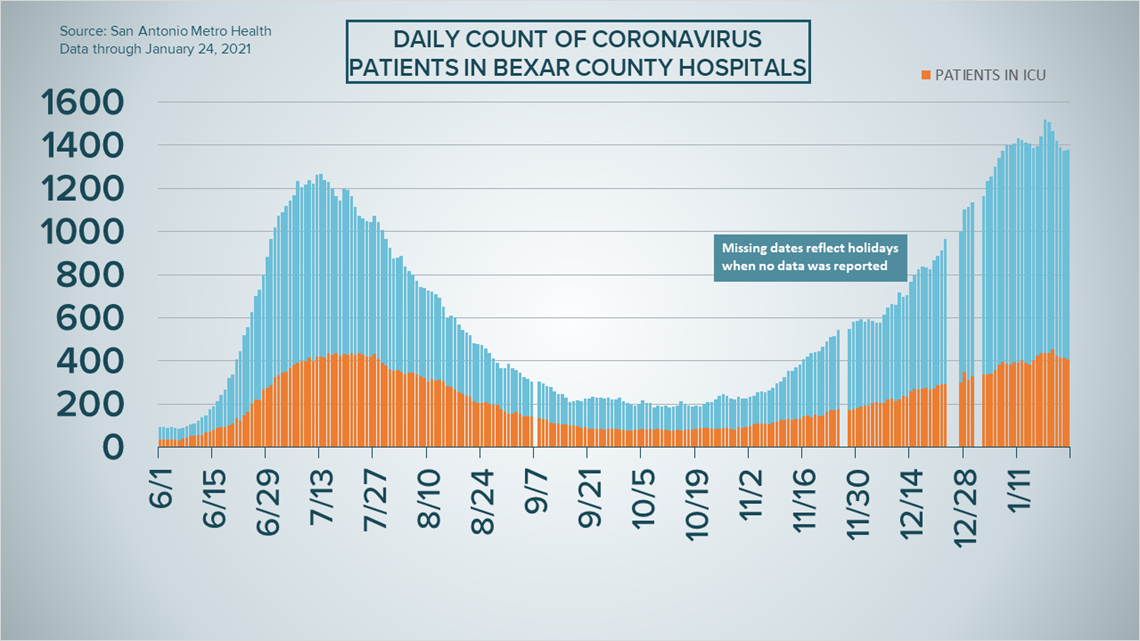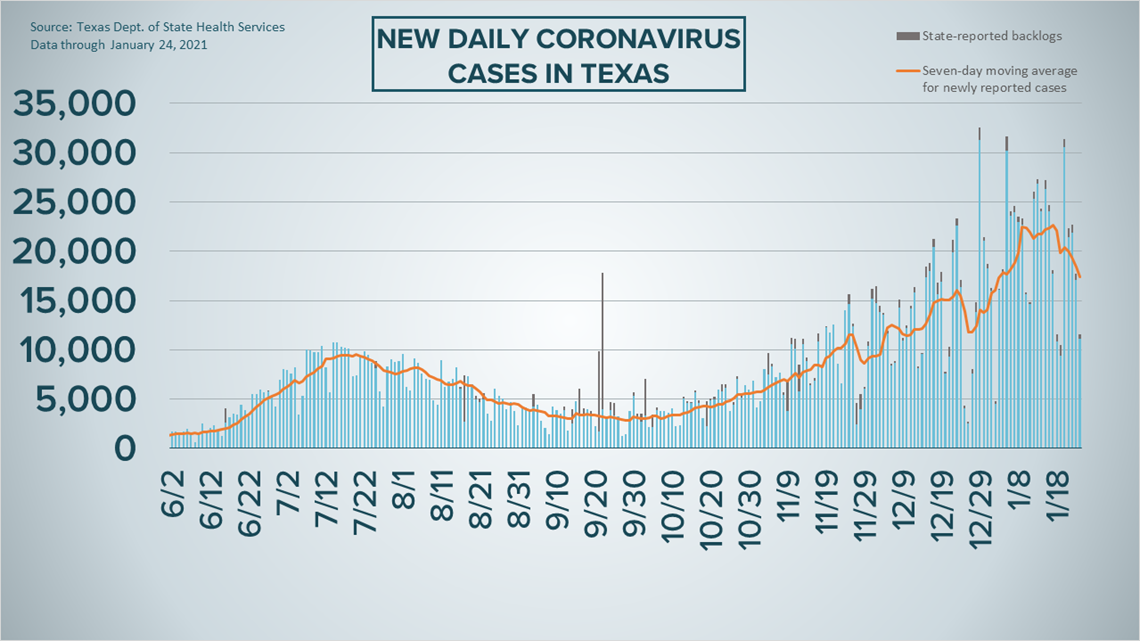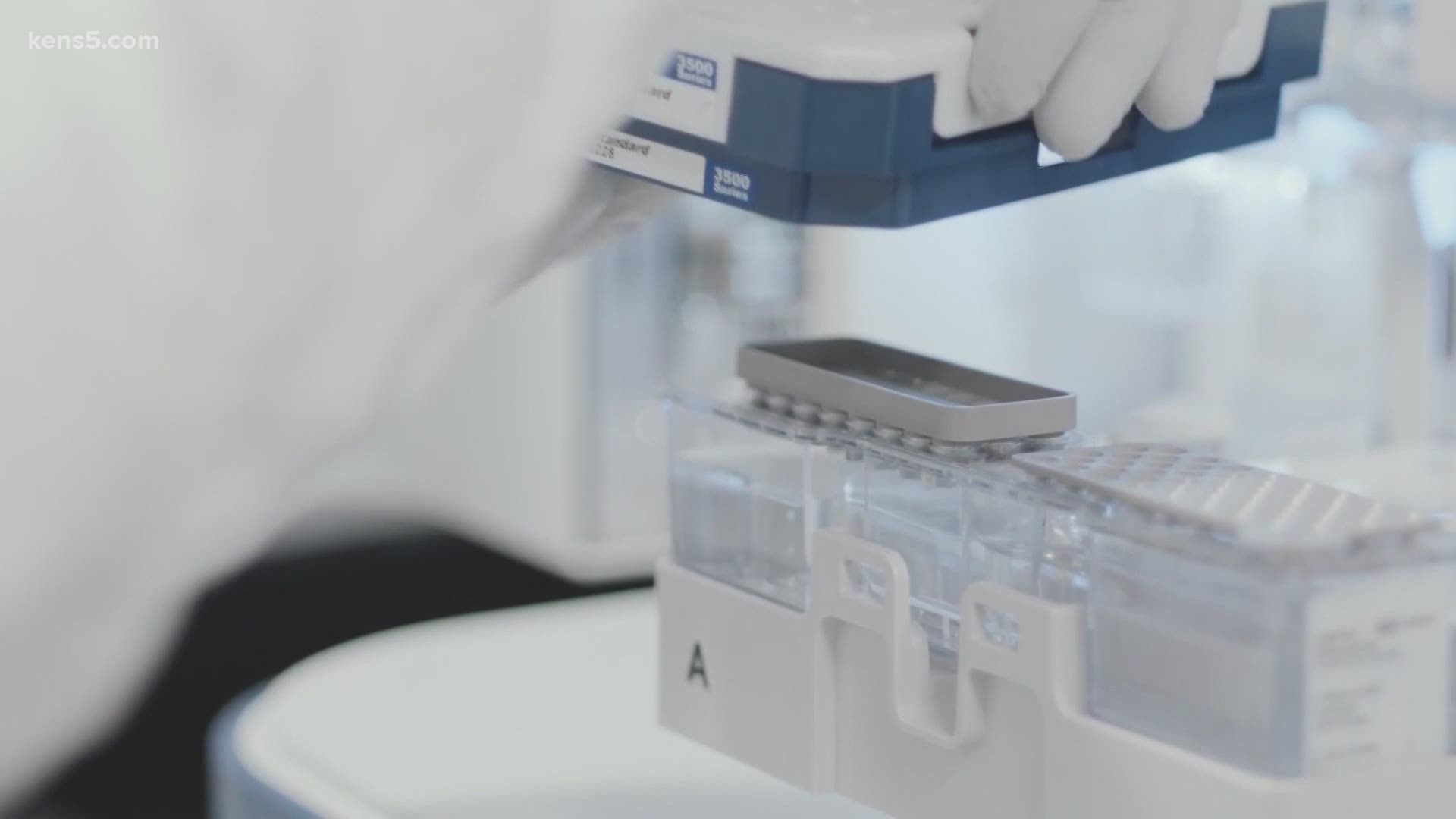SAN ANTONIO — We're tracking the latest numbers from the coronavirus pandemic in San Antonio and across Texas. Here are the latest numbers reported by Bexar and surrounding counties:
- Bexar County: On Sunday, 289 new cases were reported, bringing the total number of cases to 160,026. 16 new deaths were also reported, raising the local death toll to 1,967.
- Hays County: On Friday, officials reported 77 new cases in the county and 6 additional COVID-related fatalities. As of Friday, there are a total of 13,915 lab-confirmed local cases, while the death toll rose to 171. Officials estimate 11,047 residents have recovered, while 2,697 are still ill with the virus.
- Comal County: On Monday, officials reported 89 new cases and 11 additional COVID-related fatalities. There are a total of 7,659 cases, including 4,229 confirmed and 3,419 probable cases, while 239 county residents have died due to COVID-19 complications. The county estimates 6,729 residents have recovered, while 691 are still ill with the virus.
More county case information is available through the Texas Department of Health Services COVID-19 dashboard.
How Bexar County is trending
We've tracked how many coronavirus cases have been confirmed in Bexar County from the time officials began reporting cases in March 2020. The graphic below shows the number of cases since June and charts those daily case numbers along a 7-day moving average to provide a more accurate picture of the overall coronavirus case curve in our area and the direction we're trending amid the pandemic.
On Sunday, Mayor Ron Nirenberg reported an additional 289 coronavirus cases in Bexar County. In all, 160,026 county residents have been diagnosed with COVID-19 since the pandemic began, meaning a backlog of 218 older cases have been added to the total.
Nirenberg said that this relatively small number of new cases was likely due to a delay in reporting from the state, saying that the spread of coronavirus is still a serious problem in the city.
With the relatively lower number of cases (compared to previous days), the seven-day rolling average dropped from 1,806 on Saturday to 1,608 on Sunday.


Nirenberg also reported 16 more virus-related deaths, capping off one of the community's deadliest weeks as it pertains to COVID-19. Local leaders reported at least 10 deaths from virus complications in each of the past six days, and at least 16 in each of the past five.
At least 1,967 county residents have died from coronavirus complications, meaning a backlog of 59 older fatalities was added to the county death toll on Sunday.
After five straight days with decreasing numbers of hospital patients, the number of concurrent patients receiving treatment rose to 1,381, up six from Saturday. On Sunday, the number was 1,520.
Both the number of patients on ventilators (251) and the number of patients in intensive care (407) went down slightly on Sunday.


Coronavirus in Texas
The total number of novel coronavirus cases in the state since the pandemic began grew by 11,565 on Sunday, according to the Texas Department of State Health Services. That total includes 9,731 new confirmed cases, 1,358 new probable cases, and 476 cases attributed to backlogs not previously reported in the state's total (more details can be found at the top of this page).
Sunday's figures bring the total number of Texans diagnosed with COVID-19 to nearly 2.241 million.


Meanwhile, state health authorities also reported 208 new virus-related deaths. This came after Texas had four straight days of at least 400 fatalities. At least 34,322 Texans have died from COVID-19 complications.
The number of Texans receiving treatment at hospitals for coronavirus symptoms dropped by 410 overall patients. On Sunday, the concurrent total stood at 12,899.
The state estimates that about 1.809 million Texans have recovered, while 381,595 Texans remain ill with COVID-19.
The latest update from the Texas Education Agency showed that there have been at least 128,973 cumulative cases among staff and students across the state through January 17. That number comprises 81,118 positive student cases and 47,885 staff cases. More information can be found here.
The TEA releases new data on school cases on Fridays.
Latest Coronavirus Headlines
- US passes 25 million confirmed cases of COVID-19
- Cowboy Breakfast will not hold its major public event in 2021
- COVID-19 Vaccine Tracker: Fast facts and how to participate in Phase 1B distribution in San Antonio
- New research finds higher doses of blood thinners help some COVID-19 patients
- Wuhan returns to normal as world still battling pandemic
Coronavirus symptoms
The symptoms of coronavirus can be similar to the flu or a bad cold. Symptoms include fever or chills, cough, shortness of breath or difficulty breathing, fatigue, muscle or body aches, headache, new loss of taste or smell sore throat, congestion or runny nose, nausea or vomiting, and diarrhea, according to the Centers for Disease Control.
Most healthy people will have mild symptoms. A study of more than 72,000 patients by the Centers for Disease Control in China showed 80 percent of the cases there were mild.
But infections can cause pneumonia, severe acute respiratory syndrome, kidney failure, and even death, according to the World Health Organization. Older people with underlying health conditions are most at risk.
Experts determined there was consistent evidence these conditions increase a person's risk, regardless of age:
- Chronic kidney disease
- COPD (chronic obstructive pulmonary disease)
- Obesity (BMI of 30 or higher)
- Immunocompromised state (weakened immune system) from solid organ transplant
- Serious heart conditions, such as heart failure, coronary artery disease, or cardiomyopathies
- Sickle cell disease
- Type 2 diabetes
The CDC believes symptoms may appear anywhere from two to 14 days after being exposed.
Human coronaviruses are usually spread...
- Between people who are in close contact with one another (within about 6 feet).
- Through respiratory droplets produced when an infected person coughs, sneezes or talks. These droplets can land in the mouths or noses of people who are nearby or possibly be inhaled into the lungs.
- Some recent studies have suggested that COVID-19 may be spread by people who are not showing symptoms.
Help stop the spread of coronavirus
- Stay home when you are sick.
- Eat and sleep separately from your family members
- Use different utensils and dishes
- Cover your cough or sneeze with your arm, not your hand.
- If you use a tissue, throw it in the trash.
Find a Testing Location
City officials recommend getting a COVID-19 test if you experience fever or chills, cough, shortness of breath or difficulty breathing, fatigue, muscle or body aches, headache, new loss of taste or smell, sore throat, congestion or runny nose, nausea or vomiting, or diarrhea.
San Antonio operates several no-cost testing locations, including two walk-up locations open Monday-Sunday from 10 a.m. until 2 p.m.:
Cuellar Community Center
5626 San Fernando St.
San Antonio, TX 78237
Ramirez Community Center
1011 Gillette Blvd.
San Antonio, TX 78224
Additionally, Freeman Coliseum offers drive-through no-cost testing from Monday through Sunday between 9 a.m. and 4 p.m. An appointment is required and can be made either online or by calling (833) 213-0643.
Here's a Testing Sites Locator to help you find the testing location closest to you in San Antonio.

